Residential Solar Shading System Market Research: 2031
The Global Residential Solar Shading System Market Size was valued at $6.9 billion in 2021, and is projected to reach $10 billion by 2031, growing at a CAGR of 3.6% from 2022 to 2031. Residential solar shading systems eliminate the permeation of sun rays in buildings. Besides, they seek substantial adoption to shield against the overheating of residential spaces. These systems provide robust architectural solutions and features for solar protection & shading.
Further, they entirely change the look of a refurbished or a new residential building by making a spectacular design influence while reducing energy costs by lessening solar heat gains. They are suitable for single & multiple family dwellings, condominiums, mobile homes, and apartments both refurbished and new. In addition, residential solar shading can benefit to meet the energy conservation necessities of building regulations while lowering building running costs and growing comfort for occupants.
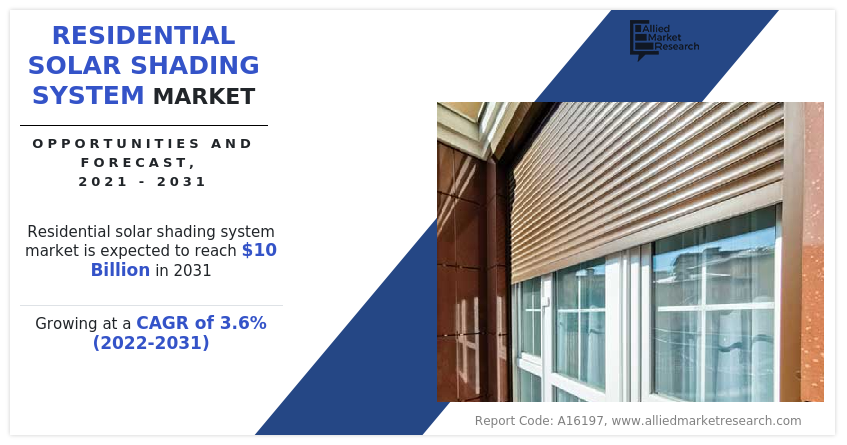
Market Dynamics
The increase in expenditures on home improvement project and remodeling activities across the globe will have a significant impact on the growth of the residential solar shading system. Furthermore, according to the U.S. Census Bureau's most recent American Housing Survey, between 2019 and 2021, American homeowners performed nearly 135 million projects for home remodeling, investing a total of $624 billion. Over the past few years, spending on home improvements has increased by roughly $100 billion. Therefore, it is anticipated that rising investment in interior design and retrofitting activities, primarily in North America and Europe, will drive the market's growth. In addition, the rapid rise in urbanization has increased the demand for motorized solar shading systems in developing countries.
One of the reasons for the growth is anticipated to be the rise in focus on public-private partnerships (PPP). These partnerships are characterized as joint ventures between government and private sector companies for the construction of public infrastructure systems. In this type of partnership, a private company handles a project and lends technical & operational expertise to government projects. The growth in public-private partnerships in different countries such as India, Africa, and China are expected to fuel the growth of the residential solar shading system end-user segment.
Further, the rise in urbanization across the world has increased the demand to build infrastructure such as residential spaces and apartments. By 2040, the global population is estimated to grow approximately by 2 billion with the urban population growing by over 40%. Motorized solar shading systems are even in high demand in developing nations due to their ability to improve quality of life, comfort, and security. These strategies play a key role for the residential solar shading system industry as solar shading have a significant effect in improving the overall performance of the residential building by providing aesthetic look, excellent thermal efficiency, which helps in improving the building efficiency thereby cutting down the energy cost.
However, factors such as unreliability in harsh weather and expensive pricing of motorized solar shading system are anticipated to restrain the residential solar shading system market growth. Moreover, technological innovations in the mechanism of residential solar shading systems products, such as adoption of switches, remote and solar adaptive shading software to control the solar shading is expected to provide lucrative opportunities for players that operate in the residential solar shading system market.
The demand for the residential solar shading system market decreased in 2020, owing to low demand from different industries due to lockdowns imposed by the government of many countries. The COVID-19 pandemic has shut down production of various products for the solar shading system end-user, owing to prolonged lockdowns in major global countries. This has hampered the growth of the residential solar shading system market significantly during the pandemic.
The major demand for construction materials was previously noticed from giant manufacturing countries including the U.S., Germany, Italy, the UK, and China, which was severely affected by the spread of coronavirus, thereby halting demand for residential solar shading. Residential solar shading system manufacturers must focus on protecting their workforce, operations, and supply chains to respond to immediate crises and find new ways of working after COVID-19 infection cases start to decrease.
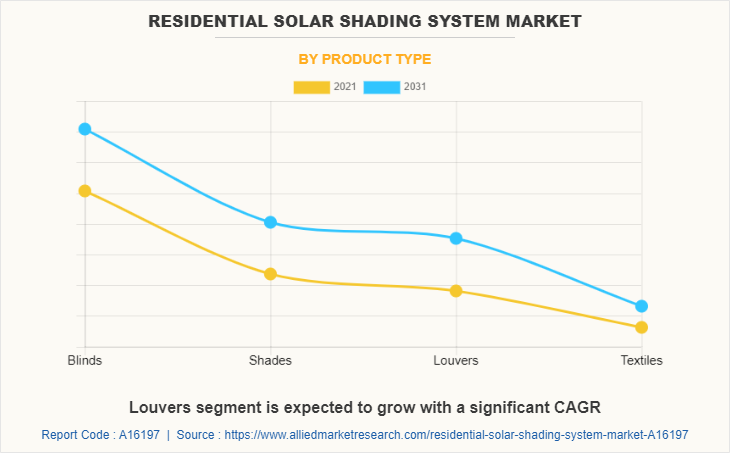
In 2021, the blinds segment dominated the residential solar shading system market, in terms of revenue, and is expected to maintain this trend during the forecast period. However, shades segment is anticipated to grow at a significant CAGR. Solar blinds are rigid window or door coverings produced using hard materials such as wood, aluminum, and PVC. They have horizontal slats, which can be tilted and slanted for adjustable daylight control. Shades are made with a solid piece of fabric, so they only have two options, open or closed.
Solar shades prevent sunlight and UV rays from entering a building premise, while still offering outside view. These shades eliminate glare, thereby being ideal for media rooms where daylight control is important. Whereas, louver is a system which allows the air to pass through it while blocking rain, debris, excessive noise, or hurricane type winds. The louvers are manufactured from materials such as metal, glass, wood, and others. The textiles is basically curtain which are used as window coverings to block both light & heat and even it controls glare by reducing the visible light that comes through the fabric while providing a beautiful linen appearance. Rise in the construction of residential buildings is expected to boost the growth of the residential solar shading system market.
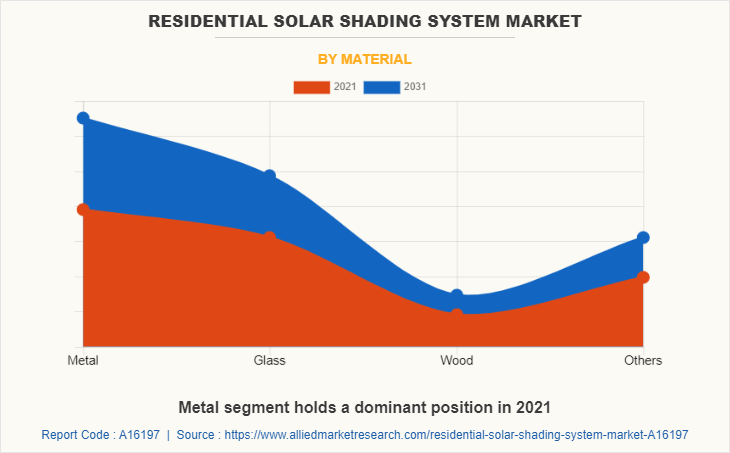
The metal segment is expected to grow at the highest CAGR during the forecast period. Even, metal segment generated the highest revenue in 2021. The metal solar shading is available in various types such as aluminum, steel, copper, and others with different surface finishes to meet specific design requirements and its available in fixed or moveable. The glass solar shading protects the residential buildings from overheating during sunny conditions. Moreover, the solar shading is available in wide range of composite-wood and natural-wood sunshades, which can be installed either vertically, and horizontally in a sliding, fixed, sliding or mobile position. In addition, increasing number of constructions of residential spaces is expected to increase the demand for solar shading system.
Further, solar shades help in making building energy efficient by preventing solar radiation from reaching into the building and hence reduces the cost of electricity by 5-7%. Such factors are anticipated to boost the growth of the market during the forecast period. In addition, rise in construction activities in developing countries such as India, China and increase in demand for high appealing design for residential building construction which increase the demand for solar shading, which is expected to boost the residential solar shading system market during the forecast period.
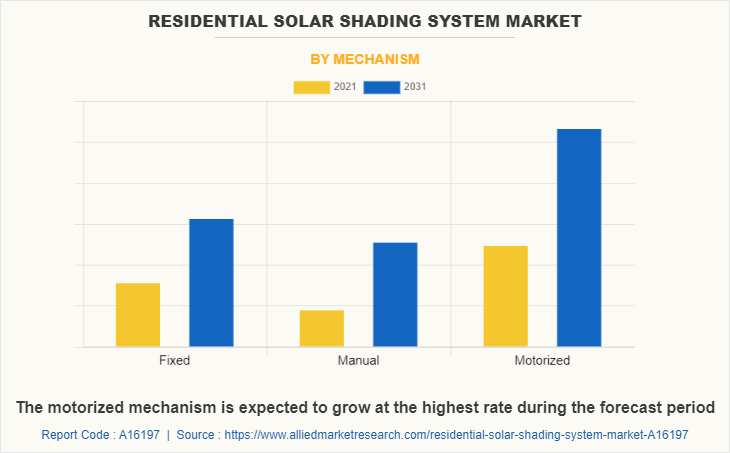
The Manual solar shading systems have an added facility of retracting fabric or the complete structure during harsh weather conditions and this manual solar shading is an ideal for flats and houses. Even, the motorized solar shading system demand is increasing in developing countries because it requires less time to operate as compare to manual solar shading. Over the last few years, residential construction has witnessed substantial growth due to the growing urban population across the globe, especially in the Asia-Pacific.
The Asia-Pacific residential construction is expected to grow at a significant rate over the forecast period as public and private entities attempt to satisfy the demand for housing created due to rapid urbanization. In addition, the residential construction expenditure of China is expected to increase every year till 2030. Rise in disposable income of population and change in standard of living drive the adoption of solar shading systems in residential properties; thereby, boosting the growth of the market.
The residential solar shading system market is segmented on the basis of product type, material, mechanism, and region. By product type, it is divided into blinds, shades, louvers, and textiles. By material, it is categorized into metal, glass, wood, and others. By mechanism, it is divided into fixed, manual, and motorized. By region, it is analyzed across North America, Europe, Asia-Pacific, and LAMEA.
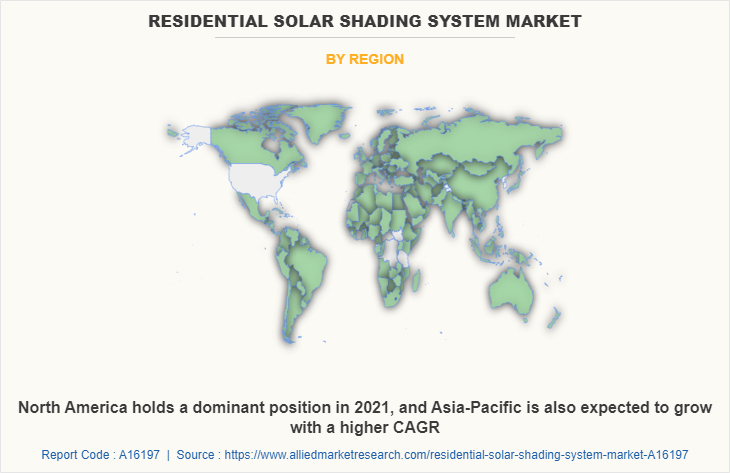
The residential solar shading system market share is analyzed across North America, Europe, Asia-Pacific, and LAMEA. North America is expected to dominate the market throughout the forecast period. Asia-Pacific is projected to experience high growth during the forecast period owing to expansion of the construction industry in the region. The major players are striving to develop manufacturing units in these markets to improve production quantities as well as serve the Asian industries such as construction. Furthermore, according to the report published by the Overseas Development Institute (ODI) based in London, the Asian regional economy grew by 6% in 2017 and is projected to grow significantly until 2025. This influences the overall growth of construction and manufacturing facilities in these regions.
Strong economic growth, rapid urbanization, and presence of large population base significantly contribute toward the growth of the residential solar system market in Asia-Pacific. In addition, increase in remodeling and repairing work in developing countries such as China, India, Vietnam, and Indonesia fuel the demand for residential solar shading system.
China is the one of the most valued construction markets in Asia-Pacific, and its construction expenditure is expected to increase every year until 2030, owing to rise in income levels and rapid urbanization. Furthermore, an upsurge in demand for solar shading system from residential sectors is expected to fuel the market growth. For instance, in December 2022, According to department of commerce, U.S. homebuilding observed the growth of 0.3% in the month of March, 2022 to a seasonally adjusted annual rate of 1.793 million units. Moreover, U.S. has witnessed a significant increase in demand for residential spaces. Such factors are expected to play crucial role in growth of residential solar shading system market. Moreover, China is estimated to have 221 cities with more than 1 million inhabitants by 2025. Moreover, according to the Organization for Economic Cooperation and Development (OECD), the middle-class population is expected to reach 1 billion by 2030, due to which the demand for residential solar shading system will increase at a higher pace in the near future, thereby propelling the growth of the market.
Competition Analysis
Competitive analysis and profiles of the major players in the residential solar shading system market, such as Arconic Corporation, Duco Ventilation & Sun Control, Glasscon GmbH, Hunter Douglas N.V., Insolroll Window Shading Systems, Lutron Electronics Co., Inc., Skyco Shading Systems, Inc., Springs Window Fashions, LLC, Unicel Architectural Corp., and WAREMA Nederland B.V. are provided in this report.
For instance, in August 2021, WAREMA Nederland B.V. which is a European market leader and manufacturer high-grade technical solar shading systems established a new production and logistics center to fulfil the demands of the growth capacity. More space, a good location, a concentrate on industry 4.0, and sustainability are all provided by this expansion.
Key Benefits For Stakeholders
- The report provides an extensive analysis of the current and emerging global residential solar shading system market trends and dynamics.
- In-depth market global residential solar shading system market analysis is conducted by constructing market estimations for key market segments between 2021 and 2031.
- Extensive analysis of residential solar shading system market is conducted by following key product positioning and monitoring of top competitors within the market framework.
- A comprehensive analysis of all the regions is provided to determine the prevailing opportunities.
- Residential solar shading system market forecast analysis from 2022 to 2031 is included in the report.
- The key players within residential solar shading system market outlook are profiled in this report and their strategies are analysed thoroughly, which help understand the competitive outlook of residential solar shading system industry.
Residential Solar Shading System Market Report Highlights
| Aspects | Details |
| Market Size By 2031 | USD 10 billion |
| Growth Rate | CAGR of 3.6% |
| Forecast period | 2021 - 2031 |
| Report Pages | 265 |
| By Product Type |
|
| By Material |
|
| By Mechanism |
|
| By Region |
|
| Key Market Players | Skyco Shading Systems, Inc., Duco Ventilation & Sun Control, Insolroll Window Shading Systems, WAREMA Nederland B.V., Hunter Douglas N.V., Lutron Electronics Co., Inc, Springs Window Fashions, LLC, Unicel Architechtural Corp., Glasscon GmbH, Arconic Corporation (Kawneer Benelux) |
Analyst Review
The residential solar shading systems are broadly used in residential buildings. Leading companies, such as Hunter Douglas and Kawneer, have witnessed significant growth and expansion of their overall consumer base in the past few years, as they offer numerous types of solar shading systems with attractive features across the globe. Moreover, innovative marketing and positioning strategies have influenced the expansion of the global residential solar shading systems market.
Furthermore, the residential solar shading systems market is expected to witness significant growth during the study period, due to development in the window industry and surge in the support offered by governments through incentives in the coming years. Besides, the usage of solar shading systems in the application segment such as window and patio buildings, is expected to increase across the world due to lowering of costs of this equipment.
Besides, solar energy being a natural source does not cause air pollution; hence, it is estimated to boost the growth of the market during the forecast period. North America is projected to be the highest revenue contributor, whereas Asia-Pacific is expected to offer lucrative growth opportunities to the key players in this market. However, high initial purchasing costs and increased installation cost of motorized systems hamper the growth of the market. On the contrary, technological advancements such as the implementation of sensors and remote control offer remunerative opportunities for the market.
North America the largest regional market for Residential Solar Shading System
The global residential solar shading system market is projected to reach $9,982.5 million by 2031, registering a CAGR of 3.6% from 2022 to 2031.
Increase in spending on home remodeling and retrofitting activities and growing demand for motorized solar shading systems in developing countries are the upcoming trends of Residential Solar Shading System Market in the world
Blinds, Shades, Louvers, Textiles are leading types of Residential Solar Shading System Market
The global residential solar shading system market was valued at $6,941.8 million in 2021
Arconic Corporation, Duco Ventilation & Sun Control, Glasscon GmbH, Hunter Douglas N.V., Insolroll Window Shading Systems, Lutron Electronics Co., Inc., Skyco Shading Systems, Inc., Springs Window Fashions, LLC, Unicel Architectural Corp., and WAREMA Nederland B.V.
The company profile has been selected on factors such as geographical presence, market dominance (in terms of revenue and volume sales), various strategies and recent developments.
Based on mechanism, the motorized segment holds the maximum market share of Residential Solar Shading System in 2021
Loading Table Of Content...



